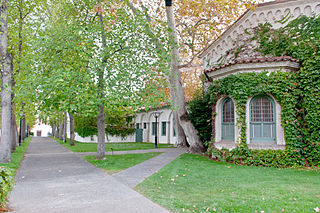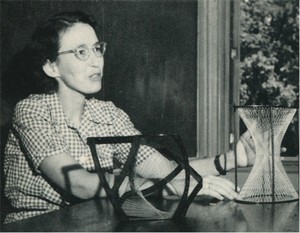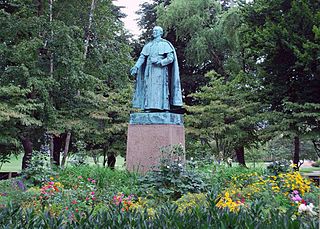Related Research Articles

Barnard College of Columbia University is a private women's liberal arts college in New York City. It was founded in 1889 by Annie Nathan Meyer as a response to Columbia University's refusal to admit women and is named after Columbia's 10th president, Frederick Barnard.

Williams College is a private liberal arts college in Williamstown, Massachusetts. It was established as a men's college in 1793 with funds from the estate of Ephraim Williams, a colonist from the Province of Massachusetts Bay who was killed in the French and Indian War in 1755. It is the second-oldest institution of higher education in the Commonwealth of Massachusetts after Harvard College.

Brandeis University is a private research university in Waltham, Massachusetts. Founded in 1948 as a non-sectarian, coeducational institution sponsored by the Jewish community, Brandeis was established on the site of the former Middlesex University. The university is named after Louis Brandeis, the first Jewish Justice of the U.S. Supreme Court.

Yale College is the undergraduate college of Yale University. Founded in 1701, it is the original school of the university. Although other Yale schools were founded as early as 1810, all of Yale was officially known as Yale College until 1887, when its schools were confederated and the institution was renamed Yale University. It is ranked as one of the top colleges in the United States.

Vassar College is a private liberal arts college in Poughkeepsie, New York, United States. Founded in 1861 by Matthew Vassar, it was the second degree-granting institution of higher education for women in the United States, closely following Elmira College. It became coeducational in 1969 and now has a gender ratio at the national average. The college is one of the historic Seven Sisters, the first elite women's colleges in the U.S., and has a historic relationship with Yale University, which suggested a merger before they both became coeducational institutions. About 2,450 students attend the college. As of 2021, its acceptance rate is 19%.
The Seven Sisters is a term that refers to seven highly selective liberal arts colleges in the Northeastern United States that are historically women's colleges. They were created to provide women with the educational equivalent to the Ivy League colleges. The name Seven Sisters is a reference to the Greek myth of The Pleiades, the seven daughters of the Titan Atlas and the sea-nymph Pleione. The daughters were collectively referred to as The Seven Sisters.

Drew University is a private university in Madison, New Jersey. Drew has been nicknamed the "University in the Forest" because of its wooded 186-acre (75 ha) campus. As of fall 2020, more than 2,200 students were pursuing degrees at the university's three schools.

Brooklyn College is a public university in Brooklyn, New York. It is part of the City University of New York system and enrolls about 15,000 undergraduate and 2,800 graduate students on a 35-acre campus.

Fordham University is a private Jesuit research university in New York City. Established in 1841 and named for the Fordham neighborhood of the Bronx in which its original campus is located, Fordham is the oldest Catholic and Jesuit university in the northeastern United States, and the third-oldest university in New York State.

Elmira College is a private, coeducational liberal arts college in Elmira, New York. Founded as a college for women in 1855, it is the oldest existing college granting degrees to women that were the equivalent of those given to men. Elmira College became coeducational in all of its programs in 1969. The college has an enrollment of under 850 students.
The School of Arts and Sciences (A&S) is the largest of the eight schools and colleges that comprise Tufts University. Together with the School of Engineering, it offers undergraduate and graduate degrees in the liberal arts, sciences, and engineering. The two schools occupy the university's main campus in Medford and Somerville, Massachusetts and share many administrative functions including undergraduate admissions, student affairs, library, and information technology services. The two schools form the Faculty of Arts, Sciences, and Engineering (AS&E), a deliberative body under the chairmanship of the president of the university. Currently, the School of Arts and Sciences employs approximately 540 faculty members. There are over 4,300 full-time undergraduates and 1700 graduate and professional students.
Douglass Residential College, part of Rutgers University-New Brunswick, is an undergraduate, non degree granting higher education program of Rutgers University-New Brunswick that is specifically for women. It succeeded the liberal arts degree-granting Douglass College after it was merged with the other undergraduate liberal arts colleges at Rutgers-New Brunswick to form the School of Arts and Sciences in 2007. Originally named the New Jersey College for Women when founded in 1918 as a degree granting college, it was renamed Douglass College in 1955 in honor of its first dean. Now called Douglass Residential College, it is no longer a degree granting unit of Rutgers, but is a supplementary program that female undergraduate students attending the Rutgers-New Brunswick undergraduate schools may choose to join. Female students enrolled at any of the academic undergraduate schools at Rutgers–New Brunswick, including, e.g., the School of Arts and Sciences, School of Engineering, School of Environmental and Biological Sciences, School of Pharmacy, Mason Gross School of the Arts, may now also enroll in Douglass Residential College, which offers special enrichment and career preparation experiences, special projects, and educational and service travel, and at which they must satisfy additional requirements specific to the college. Douglass seeks to provide the benefits of a close-knit small community of women students and offers programs specially designed to help women students to identify their unique abilities and develop confidence. These programs include, for example, a strong emphasis on opportunities to participate in service/learning trips in foreign countries, support for and expansion of racial and cultural diversity, and a wide range of training and enrichment activities offered by a career and leadership development center known as the "BOLD" Center.
Euthenics is the study of improvement of human functioning and well-being by improvement of living conditions. "Improvement" is conducted by altering external factors such as education and the controllable environments, including the prevention and removal of contagious disease and parasites, environmentalism, education regarding employment, home economics, sanitation, and housing.
The following is a timeline of women's colleges in the United States. These are institutions of higher education in the United States whose student population comprises exclusively, or almost exclusively, women. They are often liberal arts colleges. There are approximately 35 active women's colleges in the U.S as of 2021.

Women's colleges in the United States are private single-sex U.S. institutions of higher education that only admit female students. They are often liberal arts colleges. There were approximately 31 active women's colleges in the United States in 2018, down from a peak of 281 such colleges in the 1960s.

The Yale School of Art is the art school of Yale University. Founded in 1869 as the first professional fine arts school in the United States, it grants Masters of Fine Arts degrees to students completing a two-year course in graphic design, painting/printmaking, photography, or sculpture.

Fordham University School of Law is the law school of Fordham University. The school is located in Manhattan in New York City, and is one of eight ABA-approved law schools in that city. In 2013, 91% of the law school's first-time test takers passed the bar exam, placing the law schools' graduates as fifth-best at passing the New York bar exam among New York's 15 law schools.

Winifred "Tim" Alice Asprey was an American mathematician and computer scientist. She was one of only around 200 women to earn PhDs in mathematics from American universities during the 1940s, a period of women's underrepresentation in mathematics at this level. She was involved in developing the close contact between Vassar College and IBM that led to the establishment of the first computer science lab at Vassar.

FLAME University is a private, coeducational and fully residential liberal education university located in Pune, India. It was formerly known as FLAME - Foundation for Liberal and Management Education.

The history of Fordham University spans over 175 years, from the university's beginnings as St. John's College in 1841, to its establishment as Fordham University, and to its clerical independence in the mid-twentieth century. Fordham is the oldest Roman Catholic institution of higher education in the northeastern United States, and the third-oldest university in the state of New York, after New York University and Columbia University.
References
- 1 2 3 Terte, Robert (23 May 1963). "FORDHAM TO ADD A COED COLLEGE: Liberal Arts and Sciences Unit to Open on Rose Hill Campus in Fall of '64". New York Times. ProQuest 116428384.
- 1 2 Gannon, Robert (1967). Up to the Present: The story of Fordham. Garden City, NY: Doubleday & Company, Inc. p. 285.
- 1 2 Schroth, SJ, Raymond. Fordham: A History and Memoir. Revised ed. New York: Fordham UP, 2008. Print.
- ↑ "New Dean Is Appointed At Thomas More College". New York Times. 10 October 1963. ProQuest 116562926.
- ↑ "Woman is Appointed Dean of Thomas More". New York Times. 26 June 1966. ProQuest 117022957.
- ↑ "Sir John Rothenstein Named Visiting Art Professor Here". New York Times. 22 May 1967. ProQuest 117774294.
- ↑ "Vassar Names Faculty Dean". New York Times. 31 August 1971. ProQuest 119110499.
- ↑ Fleming, Thomas (10 December 1967). "Fordham Is Trying To Be catholic With a Small 'C'". New York Times. ProQuest 118105762.
- ↑ Murphy, Jean Mary (1984). Analysis of the Curriculum of Thomas More College: An Historical Perspective. Fordham University Dissertations. p. 215.
- 1 2 Gansberg, Martin (7 May 1967). "150 Fordham Women Petition for a Class on Birth Control". New York Times. ProQuest 117696525.